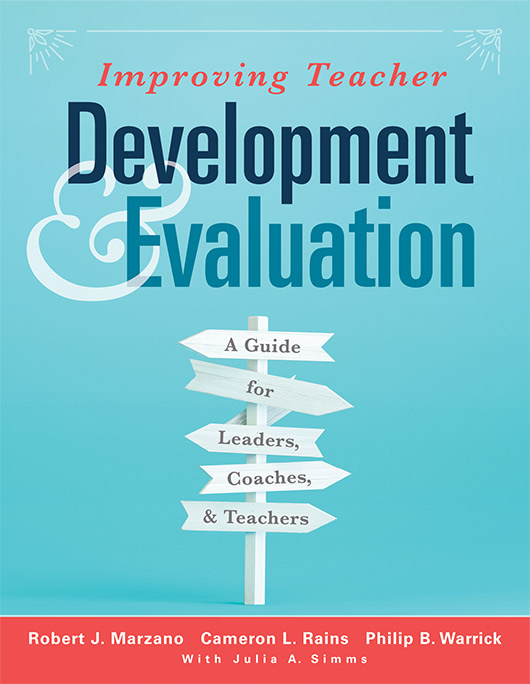Free Reproducibles
Improving Teacher Development and Evaluation
A Guide for Leaders, Coaches, and Teachers
Teachers cannot become great unless they are given the time, support, and tools to grow in their professional practice. Written for teachers, coaches, and educational leaders, this resource offers a paradigm-shifting approach to teacher development and evaluation. The authors share research-backed steps for improvement, outline the principles for successful observation, and offer extensive protocols designed to help readers fully implement the book’s recommendations.
Benefits
- Recognize the failure of past teacher evaluation efforts and its relationship with stagnant teacher development.
- Understand why the professional growth of teachers is vital to the well-being of the educational system.
- Discover the beneficial influence of teacher self-reflection and self-rating on elements of effective instruction.
- Restructure systems of classroom observation and evaluation to improve their effectiveness and encourage teacher development.
- Learn new, more reliable methods of scoring teachers’ classroom practices and students’ academic growth.
The reproducibles below that are not linked are exclusive content available only to purchasers of this book. A code printed on the inside cover of the book provides access to this exclusive content. To access these reproducibles, first sign in or create a web account. Then, select "Digital Product Access" from the sidebar in your web account. Enter the access code from the inside front cover of your book, and click "Activate Product." If you purchased this title as an ebook, email [email protected] to receive access.
Sign in or create an account
TABLE OF CONTENTS
Part I: Improving Teacher DevelopmentChapter 1: Understanding Expertise
Chapter 2: Reflecting on Teaching
Chapter 3: Coaching Teaching
Part II: Improving Teacher Evaluation
Chapter 4: The Perils of Observing Teaching
Chapter 5: Principles for Successful Classroom Observations
Chapter 6: The New Paradigm for Teacher Evaluation
Epilogue
Appendix A: Teacher Self-Rating Scales for the Forty-Three Elements of the NASOT Model
Appendix B: Design Area Observational Scales
Appendix C: Tracking Form for Teacher Reflection
Appendix D: Tracking Form for Design Areas, Observational Categories, and Elements
REPRODUCIBLES
- Figure 2.5: Growth Goal Template
- Figure 2.6: Growth Goal Post-Lesson Reflection
- Figure 2.7: Tracking Progress Chart
- Identifying Strategies for Your Goal Area
- Appendix C: Tracking Form for Teacher Reflection
- Appendix D: Tracking Form for Design Areas, Observational Categories, and Elements
Appendix A
- Teacher Self-Rating Scales for the Forty-Three Elements of the NASOT Model
- Element 1: Providing Scales and Rubrics
- Element 2: Tracking Student Progress
- Element 3: Celebrating Success
- Element 4: Using Informal Assessments of the Whole Class
- Element 5: Using Formal Assessments of Individual Students
- Element 6: Chunking Content
- Element 7: Processing Content
- Element 8: Recording and Representing Content
- Element 9: Using Structured Practice Sessions
- Element 10: Examining Similarities and Differences
- Element 11: Examining Errors in Reasoning
- Element 12: Engaging Students in Cognitively Complex Tasks
- Element 13: Providing Resources and Guidance
- Element 14: Generating and Defending Claims
- Element 15: Previewing Strategies
- Element 16: Highlighting Critical Information
- Element 17: Reviewing Content
- Element 18: Revising Knowledge
- Element 19: Reflecting on Learning
- Element 20: Assigning Purposeful Homework
- Element 21: Elaborating on Information
- Element 22: Organizing Students to Interact
- Element 23: Noticing and Reacting When Students Are Not Engaged
- Element 24: Increasing Response Rates
- Element 25: Using Physical Movement
- Element 26: Maintaining a Lively Pace
- Element 27: Demonstrating Intensity and Enthusiasm
- Element 28: Presenting Unusual Information
- Element 29: Using Friendly Controversy
- Element 30: Using Academic Games
- Element 31: Providing Opportunities for Students to Talk About Themselves
- Element 32: Motivating and Inspiring Students
- Element 33: Establishing Rules and Procedures
- Element 34: Organizing the Physical Layout of the Classroom
- Element 35: Demonstrating Withitness
- Element 36: Acknowledging Adherence to Rules and Procedures
- Element 37: Acknowledging Lack of Adherence to Rules and Procedures
- Element 38: Using Verbal and Nonverbal Behaviors That Indicate Affection for Students
- Element 39: Understanding Students’ Backgrounds and Interests
- Element 40: Displaying Objectivity and Control
- Element 41: Demonstrating Value and Respect for Reluctant Learners
- Element 42: Asking In-Depth Questions of Reluctant Learners
- Element 43: Probing Incorrect Answers With Reluctant Learners
Appendix B
- Design Area Observational Scales
- Design Area I: Providing and Communicating Clear Learning Goals
- Design Area II: Using Assessments
- Design Area III: Conducting Direct Instruction Lessons
- Design Area IV: Conducting Practicing and Deepening Lessons
- Design Area V: Conducting Knowledge Application Lessons
- Design Area VI: Using Strategies That Appear in All Types of Lessons
- Design Area VII: Using Engagement Strategies
- Design Area VIII: Implementing Rules and Procedures
- Design Area IX: Building Relationships
- Design Area X: Communicating High Expectations
SUGGESTED RESOURCES
Books
- Conzemius, A., & O’Neill, J. (2014). The Handbook for SMART School Teams: Revitalizing Best Practices for Collaboration (2nd ed.). Bloomington, IN: Solution Tree Press.
- DuFour, R., DuFour, R., Eaker, R., Many, T., & Mattos, M. (2016). Learning by Doing: A Handbook for Professional Learning Communities at Work (3rd ed.). Bloomington, IN: Solution Tree Press.
- Marzano, R. J. (2012). Becoming a Reflective Teacher. Bloomington, IN: Marzano Resources.
- Marzano, R. J. (2017). The New Art and Science of Teaching. Bloomington, IN: Solution Tree Press.
- Marzano, R. J. (2018). Making Classroom Assessments Reliable and Valid. Bloomington, IN: Solution Tree Press.
- Marzano, R. J., Norford, J. S., & Ruyle, M. (2019). The New Art and Science of Classroom Assessment. Bloomington, IN: Solution Tree Press.
- Marzano, R. J., & Simms, J. A. (2013). Coaching Classroom Instruction. Bloomington, IN: Marzano Resources.
- Marzano, R. J., Warrick, P. B., Rains, C. L., & DuFour, R. (2018). Leading a High Reliability School. Bloomington, IN: Solution Tree Press.
- Marzano, R. J., & Yanoski, D. C. (2016). Proficiency Scales for the New Science Standards: A Framework for Science Instruction and Assessment. Bloomington, IN: Marzano Resources.



